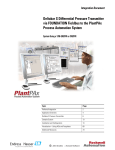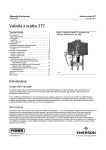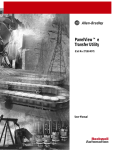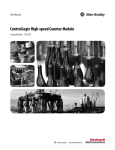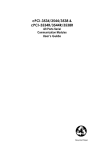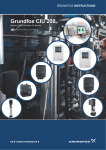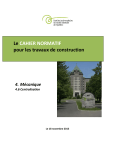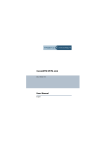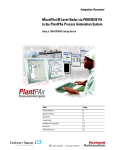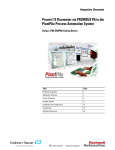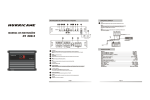Download Process Control - FOUNDATION Fieldbus™ Device - Lab-Volt
Transcript
Process Control FOUNDATION Fieldbus™ Device Configuration Courseware Sample 86002-F0 Order no.: 86002-10 First Edition Revision level: 02/2015 By the staff of Festo Didactic © Festo Didactic Ltée/Ltd, Quebec, Canada 2014 Internet: www.festo-didactic.com e-mail: [email protected] Printed in Canada All rights reserved ISBN 978-2-89640-464-3 (Printed version) ISBN 978-2-89747-204-7 (CD-ROM) Legal Deposit – Bibliothèque et Archives nationales du Québec, 2014 Legal Deposit – Library and Archives Canada, 2014 The purchaser shall receive a single right of use which is non-exclusive, non-time-limited and limited geographically to use at the purchaser's site/location as follows. The purchaser shall be entitled to use the work to train his/her staff at the purchaser's site/location and shall also be entitled to use parts of the copyright material as the basis for the production of his/her own training documentation for the training of his/her staff at the purchaser's site/location with acknowledgement of source and to make copies for this purpose. In the case of schools/technical colleges, training centers, and universities, the right of use shall also include use by school and college students and trainees at the purchaser's site/location for teaching purposes. The right of use shall in all cases exclude the right to publish the copyright material or to make this available for use on intranet, Internet and LMS platforms and databases such as Moodle, which allow access by a wide variety of users, including those outside of the purchaser's site/location. Entitlement to other rights relating to reproductions, copies, adaptations, translations, microfilming and transfer to and storage and processing in electronic systems, no matter whether in whole or in part, shall require the prior consent of Festo Didactic GmbH & Co. KG. Information in this document is subject to change without notice and does not represent a commitment on the part of Festo Didactic. The Festo materials described in this document are furnished under a license agreement or a nondisclosure agreement. Festo Didactic recognizes product names as trademarks or registered trademarks of their respective holders. All other trademarks are the property of their respective owners. Other trademarks and trade names may be used in this document to refer to either the entity claiming the marks and names or their products. Festo Didactic disclaims any proprietary interest in trademarks and trade names other than its own. Safety and Common Symbols The following safety and common symbols may be used in this manual and on the equipment: Symbol Description DANGER indicates a hazard with a high level of risk which, if not avoided, will result in death or serious injury. WARNING indicates a hazard with a medium level of risk which, if not avoided, could result in death or serious injury. CAUTION indicates a hazard with a low level of risk which, if not avoided, could result in minor or moderate injury. CAUTION used without the Caution, risk of danger sign , indicates a hazard with a potentially hazardous situation which, if not avoided, may result in property damage. Caution, risk of electric shock Caution, hot surface Caution, risk of danger Caution, lifting hazard Caution, hand entanglement hazard Notice, non-ionizing radiation Direct current Alternating current Both direct and alternating current Three-phase alternating current Earth (ground) terminal © Festo Didactic 86002-10 III Safety and Common Symbols Symbol Description Protective conductor terminal Frame or chassis terminal Equipotentiality On (supply) Off (supply) Equipment protected throughout by double insulation or reinforced insulation In position of a bi-stable push control Out position of a bi-stable push control IV © Festo Didactic 86002-10 Table of Contents Preface ................................................................................................................. VII About This Manual ................................................................................................ XI To the Instructor .................................................................................................. XIII Unit 1 FOUNDATION Fieldbus Protocol Overview ................................ 1 DISCUSSION OF FUNDAMENTALS......................................................... 1 History ....................................................................................... 1 Network topologies.................................................................... 1 HSE level (control backbone) ...................................................... 2 H1 level (field network) ................................................................ 3 Topology variations...................................................................... 3 Function block model ................................................................ 4 Standard function blocks ............................................................. 5 Flexible function blocks................................................................ 7 Communication features ........................................................... 7 Link Active Scheduler .................................................................. 7 Cyclic and acyclic communication ............................................... 7 FF Loop control example .......................................................... 8 Unit 2 Device Configuration via Software ............................................ 15 DISCUSSION OF FUNDAMENTALS....................................................... 15 FOUNDATION Fieldbus device management ........................ 15 FOUNDATION Fieldbus Software Configurator (FieldCare) .............................................................................. 16 Connection considerations ...................................................... 17 Ex. 2-1 Differential-Pressure Transmitter Configuration...................... 19 DISCUSSION .................................................................................... 19 Parameter blocks .................................................................... 19 PROCEDURE .................................................................................... 20 Setup and connections............................................................ 20 Communication with FieldCare ............................................... 20 Unlocking the device ............................................................... 22 Setting the language ............................................................... 24 Resetting to factory settings .................................................... 25 Commissioning........................................................................ 26 Commissioning for differential pressure measurements ............ 26 Commissioning for flow rate measurements .............................. 30 Commissioning for level measurements .................................... 34 Testing the transmitter ............................................................ 38 © Festo Didactic 86002-10 V Table of Contents Ex. 2-2 Control Valve Configuration (Optional) ..................................... 41 DISCUSSION .................................................................................... 41 The control valve and its controller ......................................... 41 Parameter blocks .................................................................... 42 PROCEDURE .................................................................................... 43 Setup and connections............................................................ 43 Communication with FieldCare ............................................... 44 Changing the mode of the valve ............................................. 47 Resetting to factory settings .................................................... 48 Autocalibration of the valve ..................................................... 49 Inverting the action of the valve .............................................. 51 Testing the valve ..................................................................... 52 Appendix A Conversion Table......................................................................... 59 Appendix B Installation and Configuration.................................................... 61 FieldCare installation............................................................... 61 DeviceDTMs and iDTMs installation ....................................... 68 Rockwell bridge (FFLD) DTM installation ............................... 71 Updating the catalog ............................................................... 79 Downloading new DTMs ......................................................... 81 Configuring the FFLD macro ................................................... 82 Preliminary steps ....................................................................... 82 FFLD macro ............................................................................... 83 Acronyms ............................................................................................................. 89 Bibliography ......................................................................................................... 91 VI © Festo Didactic 86002-10 Preface Automated process control offers so many advantages over manual control that the majority of today’s industrial processes use it to some extent. Breweries, wastewater treatment plants, mining facilities, and the automotive industry are just a few industries that benefit from automated process control systems. Maintaining process variables such as pressure, flow, level, temperature, and pH within a desired operating range is of the utmost importance when manufacturing products with a predictable composition and quality. The Instrumentation and Process Control Training System, series 353X, is a state-of-the-art system that faithfully reproduces an industrial environment. Throughout this course, students develop skills in the installation and operation of equipment used in the process control field. The use of modern, industrialgrade equipment is instrumental in teaching theoretical and hands-on knowledge required to work in the process control industry. The modularity of the system allows the instructor to select the equipment required to meet the objectives of a specific course. Two mobile workstations, on which all of the equipment is installed, form the basis of the system. Several optional components used in pressure, flow, level, temperature, and pH control loops are available, as well as various valves, calibration equipment, and software. These add-ons can replace basic components having the same functionality, depending on the context. During control exercises, a variety of controllers can be used interchangeably depending on the instructor’s preference. We hope that your learning experience with the Instrumentation and Process Control Training System will be the first step toward a successful career in the process control industry. © Festo Didactic 86002-10 VII Preface VIII © Festo Didactic 86002-10 Table of Contents We invite readers of this manual to send us their tips, feedback, and suggestions for improving the book. Please send these to [email protected]. The authors and Festo Didactic look forward to your comments. © Festo Didactic 86002-10 IX About This Manual Safety considerations Safety symbols that may be used in this manual and on the equipment are listed in the Safety Symbols table at the beginning of the manual. Safety procedures related to the tasks that you will be asked to perform are indicated in each exercise. Make sure that you are wearing appropriate protective equipment when performing the tasks. You should never perform a task if you have any reason to think that a manipulation could be dangerous for you or your teammates. Systems of units Units are expressed using the International System of Units (SI) followed by the units expressed in the U.S. customary system of units (between parentheses). © Festo Didactic 86002-10 XI To the Instructor You will find in this Instructor Guide all the elements included in the Student Manual together with the answers to all questions, results of measurements, graphs, explanations, suggestions, and, in some cases, instructions to help you guide the students through their learning process. All the information that applies to you is placed between markers and appears in red. Accuracy of measurements The numerical results of the hands-on exercises may differ from one student to another. For this reason, the results and answers given in this manual should be considered as a guide. Students who correctly performed the exercises should expect to demonstrate the principles involved and make observations and measurements similar to those given as answers. © Festo Didactic 86002-10 XIII Sample Exercise Extracted from the Student Manual and the Instructor Guide Exercise 2-1 Differential-Pressure Transmitter Configuration EXERCISE OBJECTIVE Become familiar with the configuration of a FOUNDATION Fieldbus differentialpressure transmitter. DISCUSSION OUTLINE The Discussion of this exercise covers the following points: DISCUSSION The DTM for the DP transmitter is part of Endress+Hauser’s FOUNDATION Fieldbus DTM package provided on the FieldCare installation DVD. Parameter blocks The DP transmitter is described in the Familiarization manual (P/N 85980-E0, 85987-E0, or 86004-E0). Parameter blocks Figure 2-3 shows the blocks of the differential-pressure DTM, as they appear in FieldCare when the device is connected. The DP transmitter has one resource block, five transducer blocks, and an analog input function block. The analog input function block takes its data from the pressure transducer block, processes it, and publishes it over the FF network. Figure 2-3.Parameter blocks in FieldCare. © Festo Didactic 86002-10 19 Ex. 2-1 – Differential-Pressure Transmitter Configuration Procedure The Procedure is divided into the following sections: PROCEDURE Setup and connections Communication with FieldCare Unlocking the device Setting the language Resetting to factory settings Commissioning Testing the transmitter Setup and connections 1. Secure the differential-pressure transmitter valve on a mounting pipe. Table 2-1.Material needed. Name Model DP Transmitter (FOUNDATION Fieldbus) 46920-A or 46921-A Electrical Unit 46970 Pneumatic Unit 46971 FOUNDATION Fieldbus Terminator 46978 FOUNDATION Fieldbus Bridge 46979 FOUNDATION Fieldbus Software Configurator 46982-A or -B Accessories 46993 2. Connect the DP transmitter to the FF Bridge’s H1-1 connectors and set up the FOUNDATION Fieldbus HSE and H1 networks as shown in Figure 2-4. Electrical Unit direct output To PC via Ethernet Figure 2-4.FOUNDATION Fieldbus connections. 3. Turn on the power supply to energize the Electrical Unit, the FF Bridge, and the DP transmitter. Communication with FieldCare 4. Launch FieldCare on your computer and start the macro for scanning the FF network with the bridge (Figure 2-5). a 20 Refer to Appendix B (Step 28) for instructions on how to set up the FF bridge macro. © Festo Didactic 86002-10 Ex. 2-1 – Differential-Pressure Transmitter Configuration Procedure Figure 2-5.Selecting the FF Bridge macro. 5. FieldCare should detect one device (the DP transmitter) as shown in Figure 2-6. Figure 2-6.Found new device. 6. After the device has been detected, FieldCare should automatically connect to the device, as indicated by the sign beside the valve in the Network view (Figure 2-7). Alternately, you can connect to the device via Device Operation Ź Connect. Communication DP transmitter Figure 2-7.Network view. © Festo Didactic 86002-10 21 Ex. 2-1 – Differential-Pressure Transmitter Configuration Procedure The Offline Parameterize window allows you to write multiple parameters all at once. 7. If the Online Parameterize window does not open right away, right-click on the device name in the Network view and select the Online Parameterize command to open the DTM pertaining to the DP Transmitter (Figure 2-8). Note the presence of the parameters tree at the left of the screen. Clicking the plus (+) and minus (-) signs opens and closes the different menus. a The menus are not necessarily organized in terms of Resource, Transducer, or Function blocks within FieldCare. Figure 2-8.Online Parameterize. 8. From now on, you can use FieldCare commands to set up the transmitter for your experiments. The following sections show you how to perform some specific configuration procedures. Unlocking the device 9. Open the Online Parameterize window. 22 © Festo Didactic 86002-10 Ex. 2-1 – Differential-Pressure Transmitter Configuration Procedure 10. Make sure that the device is not locked. If it is locked, the (key) symbol is shown on the display. There are two reasons why the device can be locked: a dip switch is activated under the display (Figure 2-9) or the device was locked remotely, via software (Figure 2-10). Figure 2-9.LOCKSTATE: Hardware (HW) locked. Figure 2-10.LOCKSTATE: Software (SW) locked. 11. If the dip switch is activated, position it in the unlocked position (down), as shown in Figure 2-11. Locking dip switch Figure 2-11.Position of the locking dip switch. © Festo Didactic 86002-10 23 Ex. 2-1 – Differential-Pressure Transmitter Configuration Procedure To lock the device remotely, set the OPERATING MENU Ź OPERATION Ź INSERT PIN No. parameter to “0”. 12. If the device was locked via software, put the DIAGNOSTIC block Actual mode to OOS and enter “100” for Setup Ź Operation Ź Insert Pin No. parameter. Put the block mode back to Auto. Setting the language To set the language used on the transmitter’s display: 13. Open the Online Parameterize window. 14. Select Block Mode in the parameters tree. Change the DISP (display transducer block) Target mode to OOS as shown in Figure 2-12. Click Apply to confirm your choice. The Actual mode should change accordingly within a few seconds. Figure 2-12.Changing DISP block mode. 24 © Festo Didactic 86002-10 Ex. 2-1 – Differential-Pressure Transmitter Configuration Procedure 15. Go to Setup Ź Display, select the desired language (Figure 2-13), and press Enter to confirm your choice. Figure 2-13.Display block Online Characterization. 16. Select Block Mode in the parameters tree. Return the DISP (display transducer block) Target mode to Auto, and click Apply to confirm your choice. Resetting to factory settings It can sometimes be preferable to start with a fresh configuration when using the transmitter, especially if you are not familiar with it. Note that resetting the unit to the factory settings has no effect on the language used on the display. To reset the transmitter to the factory settings: 17. Open the Online Parameterize window. 18. Select Block Mode in the parameters tree. Change the DIAGNOSTIC (transducer block) Target mode to OOS and click Apply to confirm your choice. The Actual mode should change accordingly within a few seconds. © Festo Didactic 86002-10 25 Ex. 2-1 – Differential-Pressure Transmitter Configuration Procedure 19. Go to Setup Ź Operation and type “7864” for Enter Reset Code parameter value (Figure 2-14). Confirm your choice by pressing Enter. Figure 2-14.Resetting to factory settings. 20. The unit will reboot with the factory settings and you will lose communication with the device. If the device does not reconnect automatically after a few minutes, close the project and restart the macro for scanning the FF network with the bridge. Commissioning When the DP transmitter is powered, it takes a few seconds to boot. At the end of the boot process, the transmitter automatically displays the MEASURED VALUE screen. The information shown on this screen depends on the last configuration saved by the user. Refer to the Resetting to factory settings section above if you need a clean configuration. Follow one of the procedures below to configure the DP transmitter for pressure, flow, or level measurement. Commissioning for differential pressure measurements Follow the procedure below to configure the DP transmitter to behave as a differential pressure measurement device. Pressure measurement is the default device mode. 21. Open the Online Parameterize window. 26 © Festo Didactic 86002-10 Ex. 2-1 – Differential-Pressure Transmitter Configuration Procedure 22. Select Block Mode in the parameters tree. Change the DP_FLOW and Pressure with Calibration Device blocks Target mode to OOS and click Apply to confirm your choices. 23. Go to Setup Ź Settings Ź Basic Setup as shown in Figure 2-15 and make the following choices: x Set Primary Value Type to differential pressure. Confirm your choice by pressing Enter. x Set PRESS. ENG. UNIT to the desired unit, usually kPa or psi. The factory setting is inH2O. Confirm your choice by pressing Enter. x Set Scale Out. Decimal according to the number of decimals that you wish to see on the display. x Verify that the DAMPING_VALUE parameter is set to an appropriate value. This parameter affects the speed at which the transmitter reacts to a change in the differential pressure sensed. The default value is two seconds, which is appropriate for most uses. Figure 2-15.BASIC SETUP screen. 24. Go to Setup Ź Settings Ź Position Adjust. as shown in Figure 2-16. Select Confirm under Pos. Zero Adjust and press Enter to set the new zero. a © Festo Didactic 86002-10 Keep in mind that the zero must be adjusted every time you reposition the unit or impulse lines. The measurements are very sensitive to displacements, even though they are of very small magnitude. 27 Ex. 2-1 – Differential-Pressure Transmitter Configuration Procedure Figure 2-16.Position Adjust screen. 25. Select Block Mode in the parameters tree. Return the DP_FLOW and Pressure blocks Target mode to Auto. Also, change the Analog Input 1 Target mode to OOS. Click Apply to confirm your choices. 26. Go to Function Blocks Ź Analog Input 1 and make the changes illustrated in Figure 2-17 and Figure 2-18: 28 x Set Transducer Scale.Units Index to the same unit as PRESS. ENG. UNIT above (e.g., kPa). x Enter the value corresponding to maximum pressure in the selected unit next to Set Transducer Scale.EU at 100%. x Select Indirect for Linearization Type. © Festo Didactic 86002-10 Ex. 2-1 – Differential-Pressure Transmitter Configuration Procedure Figure 2-17.Transducer Scale. Figure 2-18.LinearizationType: Indirect. © Festo Didactic 86002-10 29 Ex. 2-1 – Differential-Pressure Transmitter Configuration Procedure 27. Select Block Mode in the parameters tree. Return the Analog Input 1 block Target mode to Auto. 28. The unit is now configured to send the sensed pressure differential into a 0-100% range over the FF network. a The device converts automatically to 0-100% values from the entire working range of the DP transmitter (i.e. 0-50 kPa (0-7.3 psi) for the low-range or 01600 kPa (0-240 psi) for the high-range transmitter). Commissioning for flow rate measurements Keep in mind that using the low-range DP transmitter may limit the maximum flow you can measure when you use a device such as a Venturi tube. The DP can be used to automatically convert the sensed pressure differential to a flow rate value. To configure the DP for flow rate measurement, perform the procedure below. 29. Open the Online Parameterize window. 30. Select Block Mode in the parameters tree. Change the DP_FLOW and Pressure with Calibration Device blocks Target mode to OOS and click Apply to confirm your choices. 31. Go to Setup Ź Settings Ź Basic Setup as shown in Figure 2-19 and make the following choices: 30 x Set Primary Value Type to Flow. Confirm your choice by pressing Enter. x Set PRESS. ENG. UNIT to the desired unit, usually kPa or psi. The factory setting is inH2O. Confirm your choice by pressing Enter. x Make sure that Flow-Meas. Type is set to Volume p. cond. x Set Unit Flow to the desired unit (usually L/min or gal/min). x Set Scale In.EU at 100%, Max Press. Flow, and Max. Flow according to your primary element pressure curve. In the example below, the DP transmitter is configured for use with a Venturi tube, in SI units with 49 kPa corresponding to 57 L/min. x Verify that the DAMPING_VALUE parameter is set to an appropriate value. This parameter affects the speed at which the transmitter reacts to a change in the differential pressure sensed. The default value is two seconds, which is appropriate for most uses. © Festo Didactic 86002-10 Ex. 2-1 – Differential-Pressure Transmitter Configuration Procedure Figure 2-19.BASIC SETUP screen. 32. Go to Setup Ź Settings Ź Position Adjust. as shown in Figure 2-20. Select Confirm under Pos. Zero Adjust and press Enter to set the new zero. a © Festo Didactic 86002-10 Keep in mind that the zero must be adjusted every time you reposition the unit or impulse lines. The measurements are very sensitive to displacements, even though they are of very small magnitude. 31 Ex. 2-1 – Differential-Pressure Transmitter Configuration Procedure Figure 2-20.Position Adjust screen. 33. Select Block Mode in the parameters tree. Return the DP_FLOW and Pressure blocks Target mode to Auto. Also, change the Analog Input 1 Target mode to OOS. Click Apply to confirm your choices. 34. Go to Function Blocks Ź Analog Input 1 and make the changes illustrated in Figure 2-21 and Figure 2-22: 32 x Set Transducer Scale.Units Index to the same unit as Unit Flow (e.g., L/min or gal/min). x Enter the value corresponding to maximum flow in the selected unit next to Set Transducer Scale.EU at 100% (e.g., 57 L/min). x Select Primary Value for Channel. x Select Indirect for Linearization Type. © Festo Didactic 86002-10 Ex. 2-1 – Differential-Pressure Transmitter Configuration Procedure Figure 2-21.Transducer Scale. Figure 2-22.Channel and Linearization Type. © Festo Didactic 86002-10 33 Ex. 2-1 – Differential-Pressure Transmitter Configuration Procedure 35. Select Block Mode in the parameters tree. Return the Analog Input 1 block Target mode to Auto. 36. Open the Setup Ź Display screen (Figure 2-23). Make sure Main Line Cont. is set to Measured Value (PV). If not, set the DISP block to OOS mode, change Main Line Cont. to Measured Value (PV) and put the DISP block back to Auto mode. Figure 2-23.DISPLAY screen. 37. The unit is now configured to send a 0-100% proportional to the measured flow rate over the FF network. Notice that the symbol shown at the left of the measured value on the display, indicating that the transmitter is currently working as a flowmeter. Commissioning for level measurements The DP transmitter can be used to automatically convert the sensed pressure differential to a level value. To configure the DP for level measurement, perform the procedure below while the DP transmitter is connected to the process column. The impulse line must be full of water (bleed your DP if necessary). 38. Open the Online Parameterize window. 34 © Festo Didactic 86002-10 Ex. 2-1 – Differential-Pressure Transmitter Configuration Procedure 39. Select Block Mode in the parameters tree. Change the DP_FLOW and Pressure with Calibration Device blocks Target mode to OOS and click Apply to confirm your choices. 40. Go to Setup Ź Settings Ź Position Adjust. as shown in Figure 2-24. Select Confirm under Pos. Zero Adjust and press Enter to set the new zero. a Keep in mind that the zero must be adjusted every time you reposition the unit or impulse lines. The measurements are very sensitive to displacements, even though they are of very small magnitude. Figure 2-24.Position Adjust screen. 41. Go to Setup Ź Settings Ź Basic Setup as shown in Figure 2-25 and make the following choices: © Festo Didactic 86002-10 x Set Primary Value Type to Level. Confirm your choice by pressing Enter. x Set Level Selection to Level Easy Pressure. Confirm your choice by pressing Enter. x Set PRESS. ENG. UNIT to the desired unit, usually kPa or psi. The factory setting is inH2O. Confirm your choice by pressing Enter. x Set Output Unit Level Easy to the desired unit, usually mm or inch. Confirm your choice by pressing Enter. x Make sure that Calibration Mode Level Easy is set to Wet. x While the column is empty, set Empty Calib. Level Easy to “0” and press Enter. The new zero is now set. 35 Ex. 2-1 – Differential-Pressure Transmitter Configuration Procedure x Fill the column to the maximum level (100%) required for your current experiment. Set Full Calib. Level Easy to that value in the unit of your choice. Figure 2-25 is an example where a height of 30 inches corresponds to 100%. x Verify that the DAMPING_VALUE parameter is set to an appropriate value. This parameter affects the speed at which the transmitter reacts to a change in the differential pressure sensed. The default value is two seconds, which is appropriate for most uses. Figure 2-25.BASIC SETUP screen. 42. Select Block Mode in the parameters tree. Return the DP_FLOW and Pressure blocks Target mode to Auto. Also, change the Analog Input 1 Target mode to OOS. Click Apply to confirm your choices. 43. Go to Function Blocks Ź Analog Input 1 and make the changes illustrated in Figure 2-26 and Figure 2-27: 36 x Set Transducer Scale.Units Index to the same unit as Output Unit Level Easy (e.g., mm or inch). x Enter the value corresponding to maximum level in the selected unit next to Set Transducer Scale.EU at 100% (e.g., 30 inches). © Festo Didactic 86002-10 Ex. 2-1 – Differential-Pressure Transmitter Configuration Procedure x Select Primary Value for Channel. x Select Indirect for Linearization Type. Figure 2-26.Transducer Scale. Figure 2-27.Channel and Linearization Type. © Festo Didactic 86002-10 37 Ex. 2-1 – Differential-Pressure Transmitter Configuration Procedure 44. Select Block Mode in the parameters tree. Return the Analog Input 1 block Target mode to Auto. 45. Open the Setup Ź Display screen (Figure 2-28). Make sure Main Line Cont. is set to Measured Value (PV). If not, set the DISP block to OOS mode, change Main Line Cont. to Measured Value (PV) and put the DISP block back to Auto mode. Figure 2-28.DISPLAY screen. 46. The unit is now configured to send a 0-100% output proportional to the measured level. Testing the transmitter Make sure to follow the safety instructions of the Familiarization manual regarding the Pneumatic Unit when making connections to the air outlets. 47. Connect the high-pressure inlet of the DP transmitter to a variable source of pressurized air, such as an outlet of the Pneumatic Unit. a 38 In a level measurement configuration, you can vary the height of liquid in the process column instead of the air pressure to test the DP transmitter configuration. © Festo Didactic 86002-10 Ex. 2-1 – Differential-Pressure Transmitter Configuration Conclusion 48. Go to Setup Ź Process Info Ź Process Values. Vary the pressure applied to the DP transmitter and verify that PRESSURE and Primary Value.Value (pressure, flow, or level measurement in the unit of your choice) change according to the pressure variation. a Don’t forget that flow measurements are proportional to the square root of the measured pressure! 49. Go to Function Blocks Ź Analog Input 1. Make sure that Output.Value is a percentage that is proportional to the maximum process value expected. For instance, in the case of a level measurement where 30 inches correspond to 100% level, a 15-inch mark should result in an Output.Value parameter of 50%. This parameter is sent over the FOUNDATION Fieldbus network and hence, is very important to check. At the same time, the parameter status (Output.Status) should indicate GOOD. a If you wish to verify that the correct 0-100% value is passed over the FOUNDATION Fieldbus network, there are at least two ways to do so. The first one is to visualize the online value of the AI block OUT parameter in your RSFieldbus project. Another one is to check the Logix block input value received by the PLC from within RSLogix 5000. 50. Close the main switch to cut the power to the Instrumentation and Process Control Training System. CONCLUSION In this exercise, you have configured selected parameters of a FOUNDATION Fieldbus differential-pressure transmitter. REVIEW QUESTIONS 1. What is the default measurement mode of the differential-pressure transmitter? Pressure measurement. 2. What are the two ways of locking the differential-pressure transmitter? Actuating a dip switch and remotely, via software. 3. Why must the differential-pressure transmitter zero be adjusted whenever the setup is modified? Measurements are very sensitive to displacements. © Festo Didactic 86002-10 39 Ex. 2-1 – Differential-Pressure Transmitter Configuration Review Questions 4. Which types of measurement can the differential-pressure transmitter accomplish? Pressure, flow, and level measurement. 5. Which graphical tool can help you configure the differential-pressure transmitter for flow measurement? Primary element pressure curve. 40 © Festo Didactic 86002-10 Bibliography Endress+Hauser, Deltabar S FMD76/77/78, PMD70/75 (FOUNDATION Fieldbus), Differential pressure measurement – Operating Instructions, publication BA301P/00/EN, June 2009. Endress+Hauser, FieldCare – Getting Started, publication BA027S/04/c4, January 2010. Fieldbus Foundation, March 2010. System Engineering Guidelines – Revision 3.1, Fisher Controls International (Emerson Process Management), Fisher® FIELDVUE™ DVC6000f Digital Valve Controllers – Instruction Manual, publication D103189X012, December 2009. Liptak, B.G., Instrument Engineers’ Handbook: Process Software and Digital Networks, Third Edition, Pennsylvania: Chilton Book Company, 2002, ISBN 0-8493-1082-2. Rockwell Automation, Foundation Fieldbus Linking Device – User Manual, publication 1757-um010B-en-e, March 2009. © Festo Didactic 86002-10 91







































